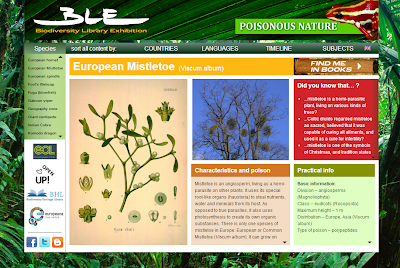It is Friday, time for the Spice of the week, but we
have something special for you today. We would like to introduce a new BLE
topic describing various poisonous species from different parts of the world –
Poisonous Nature.
 |
| BLE - Poisonous Nature |
 |
| Mistletoe in crown of tree - EOL. |
Here is the first highlight from Poisonous
Nature, one of the symbols of Christmas, which brings fortune and blessing to
your homes – European Mistletoe (Viscum
album). Did you know that mistletoe
contains the poison lectin, which strengthens the body's immune reaction
against cancer and even slows tumor growth?
 |
| European Mistletoe - Viscum album - BHL. |
Mistletoe is an angiosperm,
living as a hemi-parasite on other plants. It uses its special root-like organs
(haustoria) to steal nutrients, water and minerals from its host. As opposed to
true parasites, it also uses photosynthesis to create its own organic
substances. There is only one species of mistletoe in Europe: European or
Common Mistletoe (Viscum album). It
can grow on deciduous or coniferous trees, dependent on the subspecies. The
poisonous qualities of mistletoe have not been conclusively proven; only larger
quantities are known to cause diarrhea and stomachaches. Only in nursing
infants can poisoning have more severe consequences.
 |
| European Mistletoe - Viscum album - image is under CC-BY-SA, from The Royal Botanic Garden Edinburgh - OpenUp! content on Europena. |
You can find more about the mistletoe on BLE PoisonousNature. We wish you great Christmas Holidays and of course, stay tuned!!






